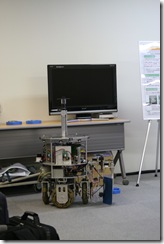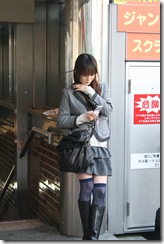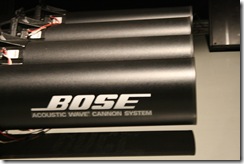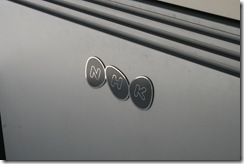 On our first day in Tokyo we are visiting Tokyo Denki, a joint venture of numerous (previously separate) universities. Even though they still work partially separate they now at least work together. They had some cool demonstrations including a robot that could deploy wireless sensor networks by dropping balls with the electronics in them, including a camera to be able to view the surroundings. They want to use the system in major earthquakes when its critical to get a fast overview of the surroundings and even in situations that are too dangerous for humans (structural hazards etc).
On our first day in Tokyo we are visiting Tokyo Denki, a joint venture of numerous (previously separate) universities. Even though they still work partially separate they now at least work together. They had some cool demonstrations including a robot that could deploy wireless sensor networks by dropping balls with the electronics in them, including a camera to be able to view the surroundings. They want to use the system in major earthquakes when its critical to get a fast overview of the surroundings and even in situations that are too dangerous for humans (structural hazards etc).
 I don’t remember much else from the presentations as I am coming down with the flu or something and I had a few pain killers in the break to try to keep my focus. The next thing I know the lunch had arrived: they asked Ivo if we wanted a Japanese style or Western style lunch and so they had ordered a huge amount of sandwiches and fruit salads. The lunch was awesome and the sandwiches had a huge variety to suit everyone’s taste. To my surprise the Japanese people seemed to like them as well – making me wonder why Japanese people don’t eat bread more often (and making it easier for us Dutch to find decent food around here).
I don’t remember much else from the presentations as I am coming down with the flu or something and I had a few pain killers in the break to try to keep my focus. The next thing I know the lunch had arrived: they asked Ivo if we wanted a Japanese style or Western style lunch and so they had ordered a huge amount of sandwiches and fruit salads. The lunch was awesome and the sandwiches had a huge variety to suit everyone’s taste. To my surprise the Japanese people seemed to like them as well – making me wonder why Japanese people don’t eat bread more often (and making it easier for us Dutch to find decent food around here).
 After the lunch we headed for NHK – the Japanese BBC. They are also funded by non-commercial sources and apparently exists largely from the money they receive from Japanese households. NHK has a huge video archive with most of it with closed captions.
After the lunch we headed for NHK – the Japanese BBC. They are also funded by non-commercial sources and apparently exists largely from the money they receive from Japanese households. NHK has a huge video archive with most of it with closed captions.
They working very hard on techniques to harvest this data for future use. One of the cool things we saw was a program that generated a trailer from a random program by using the EPG (electronic program guide) as a guide and the captions to match the extract to. The result is a 30 second trailer summarizing the program. The results were amazing.
 Another use is to index the captions to create a multimedia encyclopedia from the terabytes of video data stored in the NHK data center to be able to search for particular content.
Another use is to index the captions to create a multimedia encyclopedia from the terabytes of video data stored in the NHK data center to be able to search for particular content.
Besides the IT part of the television / media world we also got to experience the next generation of TV: SHV or Super High Vision video is 16 times the resolution of current HD material (so much for my HD ready TV, it looks like a toy next to this stuff).
According to NHK it will be the last 2D media standard as humans are unable to see more details than SHV can show. That, accompanied with the 22.2 surround system (yes, that is twenty-two channels of sound and 2 channels for the subwoofers… So much for my DTS system at home LOL) made it quite an experience to see. We sat a few meters from the cinema sized screen and we could not see any pixels unlike any beamer system I had seen up to then.
 Right now the system is in development and not nearly ready for normal use even though NHK is aspiring to switch to SHV in a few years. The current system uses 3 humongous beamers, insane cooling to keep it all running and uses a few hundred terabyte of storage for a half hour demonstration. In case this all means nothing to you: you can get a few decent Bentleys for the equipment these people use to store their next generation videos. Did I mention that they work together with Bose to develop the sound system for SHV? All of the speakers and the sound system is custom build for this purpose…. daaaaang ^-^.
Right now the system is in development and not nearly ready for normal use even though NHK is aspiring to switch to SHV in a few years. The current system uses 3 humongous beamers, insane cooling to keep it all running and uses a few hundred terabyte of storage for a half hour demonstration. In case this all means nothing to you: you can get a few decent Bentleys for the equipment these people use to store their next generation videos. Did I mention that they work together with Bose to develop the sound system for SHV? All of the speakers and the sound system is custom build for this purpose…. daaaaang ^-^.
